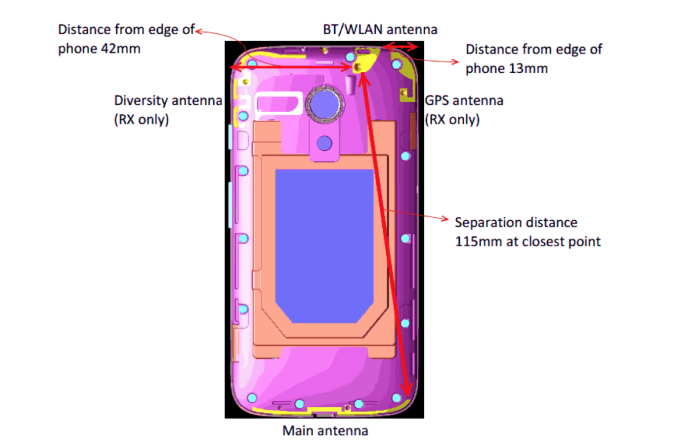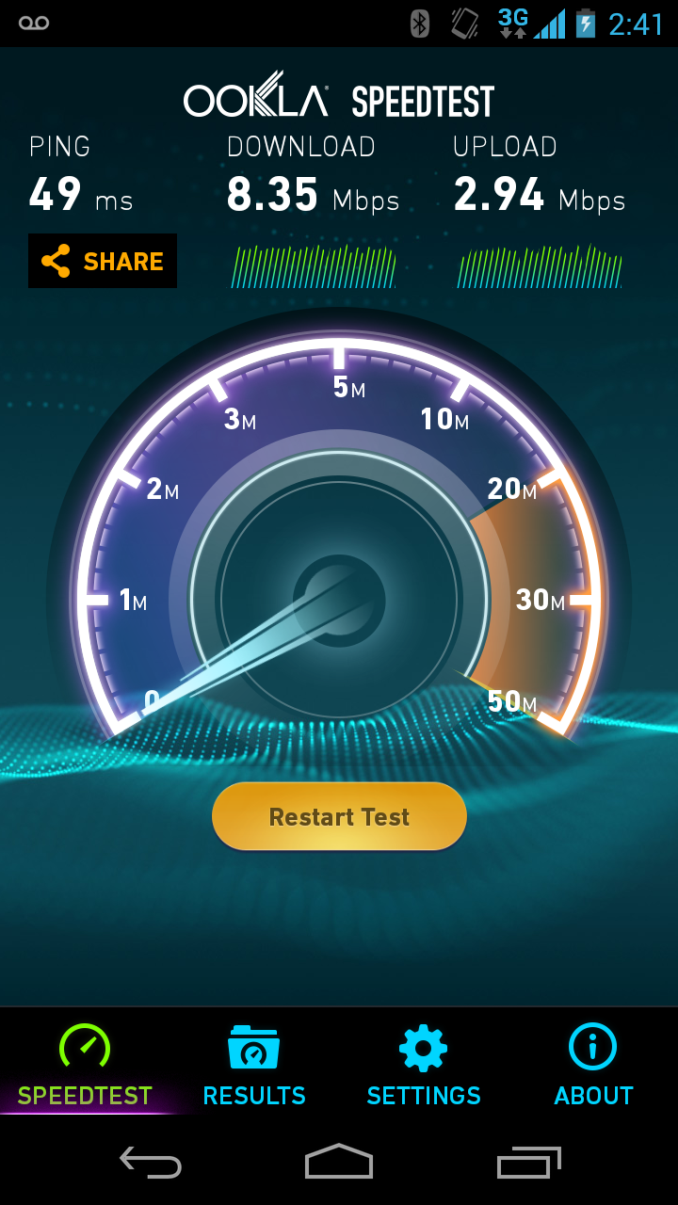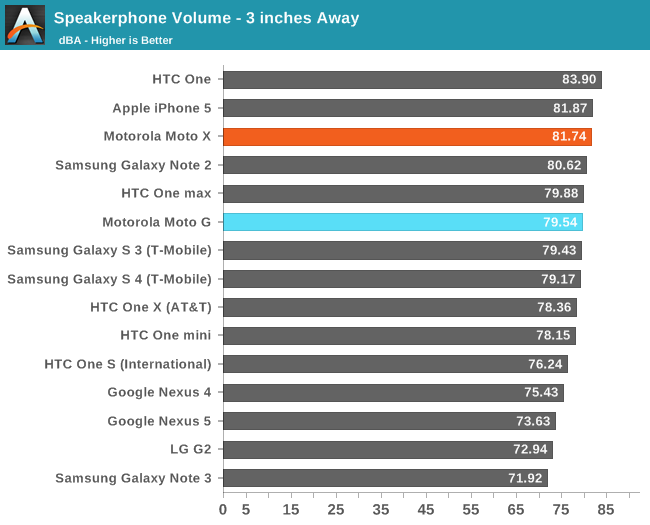Motorola Moto G Review
by Brian Klug on December 18, 2013 2:00 PM EST- Posted in
- Smartphones
- Motorola
- Mobile
- *VA
- Cortex A7
- snapdragon 400
- Moto G
Cellular
The cellular side of the Moto G is an interesting one, at least for those who have kept constantly abreast of wireless banding configurations and the state of mobile RF. At the high end, pentaband WCDMA is now essentially ubiquitous, with parity LTE banding (given the shared nature of ports on the transceiver) and at least a handful more bands for whatever’s appropriate to the region. There’s no global LTE band combination equivalent to quad band GSM or pentaband WCDMA that has emerged quite yet, but it’s getting there, and in the next generation or two we’ll undoubtedly finally see it come to fruition.
|
Moto G (US GSM) |
Moto G (Global GSM) |
Moto G (CDMA) |
|
| Baseband | MSM8x26 - (Up to HSDPA 21.1 Enabled, EVDO Rev.A for CDMA) | ||
| Transceiver | WTR2605/WFR2600 (?) | ||
| GSM | 850/900/1800/1900 MHz | - | |
| CDMA2000 | BC: 0/1/10 | - | 850, 1900 MHz |
| WCDMA |
850, 1700/2100 (AWS), 1900 MHz (Bands 2, 4, 5) |
850, 900, 1900, 2100 MHz (Bands 1,2,5,8) |
- |
| LTE | - | - | - |
The Moto G however comes in a number of different flavors with different band combinations – there’s US GSM, Global GSM, and CDMA. I also suspect there’s at least one more dual SIM variant that we haven’t seen crop up just yet (Update: Apparently this exists already, XT1033 is the dual SIM variant, thanks @evefavretto). On the back case of Moto G there’s a space whose shape matches the microSIM tray at top, and on the board there’s a shield covering pads that are undoubtedly for a microSIM. Interestingly enough Motorola sampled me the Global GSM variant of the Moto G which lacks Band 4. I’ve been using it on T-Mobile successfully however thanks to the relative ubiquity of the 1900 MHz WCDMA carrier in my market. The US GSM variant of the Moto G trades Band 4 for 1 and 8 (2100 and 900 MHz), two popular bands internationally. I’ve seen Moto G erroneously listed as being a pentaband WCDMA phone, which it unfortunately isn’t.

Primary Rx/Tx at bottom, Diversity Rx up top, WLAN/BT, GNSS Rx
Moto G does offer a leg up with receive diversity for CDMA1x/EVDO and HSPA+, something that some HSPA+ flagships from this generation amazingly enough still don’t include. The transceiver is WTR2605 for the primary Rx and Tx ports, and WFR2600 for the additional Rx diversity path. I have no idea what the port configurations look like for WTR2605, but I’d imagine it looks like a cut down WTR1605 of some kind. I have a suspicion that WTR2605 was designed for a quad band UMTS configuration with Bands 1,2,5, and 8, so it might indeed already be port limited in the Global GSM Moto G variant. I also wouldn’t be surprised if there’s some ready made front end module at the front of the whole thing.
Moto G arrives without LTE and instead offers up to single carrier HSPA+ with 64QAM, for up to 21 Mbps on the downlink. Although MSM8x26 itself has a modem block capable of up to dual carrier HSPA+ and category 4 LTE, it seems as though Motorola went for single carrier HSPA+ in the Moto G for time to market reasons, with the LTE and dual-carrier HSPA+ enabled software tree likely slotting in a quarter later than the initial code drop with single carrier HSPA+.


Not bad for single carrier HSPA+ on T-Mobile USA
I’ve been pretty pleased with the cellular performance of the Moto G, even using the variant that lacks Band 4 on T-Mobile USA. Not having LTE made me initially skeptical of it getting operator traction in the US, but it seems as though Motorola has actually had success at least on some prepaid tiers. I’ve been spoiled with LTE devices for a long time now, but single carrier HSPA+ is absolutely still survivable.
WLAN
WiFi connectivity on Moto G is single band 2.4 GHz 802.11n with BT 4.0 and FM receive. On the Moto G, that connectivity is courtesy the new WCN3620 BT/FM/WLAN RF combo chip in a wafer scale package. We’ve now seen WCN3660, the initial dual band combo, then WCN3680 which added 802.11ac, and now WCN3620, the cost reduced version which is single band 802.11n and no doubt offered at a competitive price point with the rest of the platform.
The WLAN/BT stack doesn’t do any antenna sharing and instead has its own transmit and receive path on the top of the Moto G. I don’t have any complaints about WLAN range on the Moto G.
To evaluate performance we turn to the same iPerf test same as always. I was able to attach the Moto G to my network at the 65 Mbps PHY rate that corresponds to long guard interval with a 20 MHz channel.

Performance is pretty decent at just over 50 Mbps. It’s a significant delta over the latest devices with dual band 80 MHz 802.11ac support, but again, totally solid relative to the tier it’s in.
Speakerphone and Noise Canceling
Speakerphone on the Moto G seems to be a big chamber if you take the back off, but there’s a relatively small seal against the whole affair, although the grille has larger holes than Moto X’s relatively tiny ones. Loudness is competitive, but unsurprisingly short of Moto X.

I’d describe Moto G’s speaker as decent, not overly loud or rich sounding.
Dual microphone noise suppression is still a somewhat notable feature at the midrange. In the case of Moto G, Qualcomm’s Fluence package is used in a configuration with the primary microphone at bottom and secondary at very top. I did some digging and also found that Moto G is using Qualcomm’s WCD9302 audio codec which we haven’t seen before, again a more midrange variant. I’ll leave the earphone/line out audio testing for Chris to evaluate.
Noise suppression on the Moto G is decent, but seems to have longer adaptation time than the Moto X. Using the exact same setup, I definitely noticed better rejection on Moto X as well, with less noise being passed through at the same volume level. I should also note that the Moto G does not appear to be AMR-WB enabled on T-Mobile.
GNSS
GNSS onboard the Moto G is the same Gen 8B as we’ve seen on 8974, which translates to support for GPS (USA “Navstar”), GLONASS (Russia), and Beidou (China), although the spec table for Moto G only lists GPS and GLONASS, leading me to believe Beidou might be reserved for devices destined for China. There’s a discrete antenna for GNSS on the Moto G, and I had no issues with getting fast, accurate 3D fixes. I remain impressed with Qualcomm’s GNSS which obviously benefits from integration right into the SoC.










120 Comments
View All Comments
Taracta - Thursday, December 19, 2013 - link
"Moto G arrives without LTE and instead offers up to single carrier HSPA+ with 64QAM, for up to 21 Mbps on the downlink. Although MSM8x26 itself has a modem block capable of up to dual carrier HSPA+ and category 4 LTE, it seems as though Motorola went for single carrier HSPA+ in the Moto G for time to market reasons, with the LTE and dual-carrier HSPA+ enabled software tree likely slotting in a quarter later than the initial code drop with single carrier HSPA+."Does this means that the Moto G will have LTE in the near future? This would put my only major reservation about this phone to rest!
Mogster - Thursday, December 19, 2013 - link
I'm wondering that as well. Even if it's not officially supported, could the phone be hacked to use LTE or dual-carrier HSPA+? Guess I'll check XDA Developers, maybe they have some info on it.Also, any idea if the CPU can be overclocked?
orenc17 - Thursday, December 19, 2013 - link
now that the kitkat update began seeding will you update the reviewto see if kitkat actually improved anything?
smarty69 - Friday, December 20, 2013 - link
As I knew Tesco were cheaper than phones 4 U for the moto g phones 4 U were selling it 16GB for £149.99 + £10 top up any network (so they are unlocked!)& had them in stock :)
Phones 4 U will if you ask customer services nicely price match :-)
& if you've ordered online you have 7 days change of mind policy .....so I said I don't want to return it but Tesco is cheaper than you! so they refunded me back the difference! .... & their deal was an unlocked moto g with free white phone back case & a £10 top up & entry into their Christmas giveaway draw (I got a scratch card sent to me with a code entered it online ) & won 25% off all accessories!
I got these as well :0)
& only paid the same as Tesco £129!!!!!
Hope this helps grab a bargain....loving my Moto g ;0)
Excellent Battery life BTW & Go online & read a few Android tips.... eg use auto brightness & stop apps running in background
Use power saving etc etc I get 23 hours out of my phone with 8 hours of actual on screen time omg! :0) that's amazing.....
Merry Christmas ppls X
bhima - Friday, December 20, 2013 - link
Really great review Brian. This is probably the most accurate review of this device on the internet. So far I'm really enjoying my Moto G, especially the battery life compared to my old Galaxy S1.metayoshi - Friday, December 20, 2013 - link
I've been reading this review in installments and finally got to the battery life section... Wow, that's impressive. It has got to be the best battery life on any smartphone in this class. And it has Android 4.4.2 as of the writing of this comment? Way to go Motorola. They have really stepped up their game.unconnectme - Saturday, December 21, 2013 - link
Moto G is a game changer for the consumer. Moto G + service from 35orless. Savings versus 2 year agrement over $1,000will2 - Sunday, December 22, 2013 - link
@Brian. Very good detailed review of most of it, but no mention of any means of getting the screen mirrored to TV, and if it plays at least 720p films smoothly. I read elsewhere it doesnt have any wired TV-out, but are you able to check if it supports Miracast ? ... and if it plays films smoothly ?blzd - Monday, December 23, 2013 - link
First Nexus 5 now the Moto G. Google are on a roll here for those price:performance sweet spots.Also 4.4 Kit Kat supports screen mirroring natively.
truminspiron - Monday, December 23, 2013 - link
Oh so good for see but not good for buy...